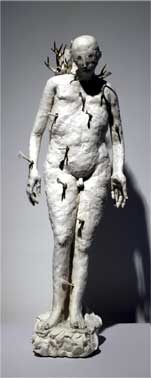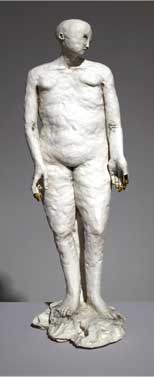 |
||
FRAGMENTED FIGURE |
| |
||||
Claire Curneen Exhibited Works |
||||
| |
||||
Fragmentation in Claire Curneen’s Ceramicsby Natasha Mayo
|
||||
|
Claire Curneen’s figures are constructed from multiple, overlaid plates of porcelain creating cracks and apertures over the surface of the body. Rather than representing skin, these properties appear almost as a magnification of skin tissue, exposing its composition of cells and at the same time revealing their potential separation. The body is depicted in sections, inferring an inherent fragility, the feeling that – even without touch – the surface may break. This sense of fragility is informed, in part, by the activity of our perception, the particular way in which our eyes and body interact with the work. As the horizontal lines defining each cell section are predominant, our eyes are directed across the body darting from left to right visually dissecting the form, reinforcing its fissures and indentations and a sense of the figure’s potential collapse. There is a sense in which, as our shadow exerts shifting weight over their form, bruising its surface, allowing us to touch and probe its skin, its properties become an equivalent to our own, a skin both feeling and felt. As we move around the form – placing our body between the figure and light, causing it to flicker over the surface – the form can appear to move, its skin breathe. Our properties are in a sense transposed onto their properties allowing us to experience for ourselves their unsteady balance and exposed vulnerability1. Notes1. The idea of experiencing the world through the body's relative textures and gestures is taken from Merleau-Ponty, M., Phenomenology of Perception, trans. Smith, Routledge & Keegan, 1962.back to text
|
|
Recommended Reading Published on ICRC: Christie Brown:
|
||
| |
||||
| University of Wales Intitute, cardiff | Adorfa Prifysgol Cymru, Caerdydd | ||||





